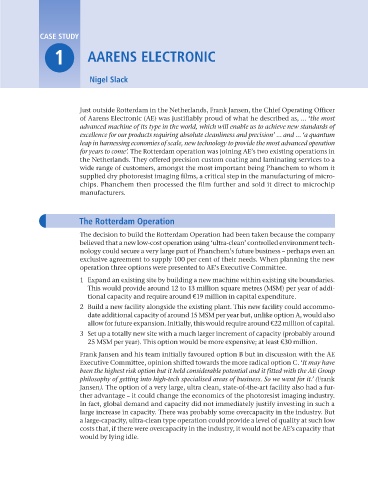Page 398 - Operations Strategy
P. 398
CaSE Study
1 aarEnS ElECtrOniC
nigel Slack
Just outside Rotterdam in the Netherlands, Frank Jansen, the Chief Operating Officer
of Aarens Electronic (AE) was justifiably proud of what he described as, … ‘the most
advanced machine of its type in the world, which will enable us to achieve new standards of
excellence for our products requiring absolute cleanliness and precision’ … and … ‘a quantum
leap in harnessing economies of scale, new technology to provide the most advanced operation
for years to come’. The Rotterdam operation was joining AE’s two existing operations in
the Netherlands. They offered precision custom coating and laminating services to a
wide range of customers, amongst the most important being Phanchem to whom it
supplied dry photoresist imaging films, a critical step in the manufacturing of micro-
chips. Phanchem then processed the film further and sold it direct to microchip
manufacturers.
the rotterdam Operation
The decision to build the Rotterdam Operation had been taken because the company
believed that a new low-cost operation using ‘ultra-clean’ controlled environment tech-
nology could secure a very large part of Phanchem’s future business – perhaps even an
exclusive agreement to supply 100 per cent of their needs. When planning the new
operation three options were presented to AE’s Executive Committee.
1 Expand an existing site by building a new machine within existing site boundaries.
This would provide around 12 to 13 million square metres (MSM) per year of addi-
tional capacity and require around €19 million in capital expenditure.
2 Build a new facility alongside the existing plant. This new facility could accommo-
date additional capacity of around 15 MSM per year but, unlike option A, would also
allow for future expansion. Initially, this would require around €22 million of capital.
3 Set up a totally new site with a much larger increment of capacity (probably around
25 MSM per year). This option would be more expensive; at least €30 million.
Frank Jansen and his team initially favoured option B but in discussion with the AE
Executive Committee, opinion shifted towards the more radical option C. ‘It may have
been the highest risk option but it held considerable potential and it fitted with the AE Group
philosophy of getting into high-tech specialised areas of business. So we went for it.’ (Frank
Jansen). The option of a very large, ultra clean, state-of-the-art facility also had a fur-
ther advantage – it could change the economics of the photoresist imaging industry.
In fact, global demand and capacity did not immediately justify investing in such a
large increase in capacity. There was probably some overcapacity in the industry. But
a large-capacity, ultra-clean type operation could provide a level of quality at such low
costs that, if there were overcapacity in the industry, it would not be AE’s capacity that
would by lying idle.
Z01 Operations Strategy 62492.indd 373 03/03/2017 15:36

